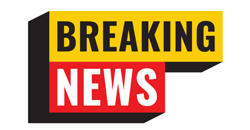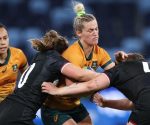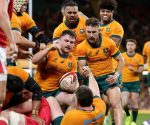NRL News: ‘Rather be here than Lidcombe’
Two weeks after Lachie Galvin set the NRL news cycle ablaze when the teenager informed his junior club he had no intention of renewing his contract beyond 2026, he was ecstatic after playing his part in the Wests Tigers’ dramatic 20-18 extra-time triumph over Cronulla.
The Tigers responded to his shock announcement by dumping the prodigious 19-year-old to NSW Cup, with club chief executive Shane Richardson and coach Benji Marshall at loggerheads with Galvin’s agent Isaac Moses.
But he played a starring role in his comeback match, making a crucial try-saving tackle in the final minute of regulation to help the home side record “one of the best wins I’ve been a part of” at Leichhardt Oval.
“I’ll be honest, I’d rather be here than at Lidcombe on a Sunday. It was a great win and it’s great to come out here and win in front of our fans and I can’t be more grateful to be out here with the NRL team again and I loved it,” he told Nine after the game.
“I don’t really get nervous, more excited. I just wanted to get in the game, get in the rhythm of the game, get back into first grade, that’s all I really wanted.
“It wasn’t about me, it was about the team this week and that’s what we wanted, to come out and win like we did. To nail that at the end was amazing.”
Halfback Jarome Luai and fellow co-captain Api Koroisau had welcomed Marshall’s decision to demote Galvin to reserve grade. But after the Tigers lost in an ill-disciplined defeat to Parramatta on Easter Monday, Marshall pulled rank and recalled Galvin to the NRL side after just a week-long exile.
Galvin set up the Tigers’ opening try and rose to the occasion without Luai, who spent 15 second-half minutes undergoing a head injury assessment.
Luai and winger Sunia Turuva both took digs at the teenager on social media.
“(But) never once have I said I don’t want to play with him,” Luai said after the win over the Sharks. “I love playing with the kid and I love what he brings to this team. I’m proud of the boys.”

Royce Hunt palms off a defender. (Photo by Darrian Traynor/Getty Images)
Galvin was greeted with light boos when the team list was read out to a packed Wayne Pearce Hill on Sunday, but that quickly died down when he set up Samuela Fainu for the opening try of the match.
“I thought he was great, he just went out and played footy with that first try he set up that calmed the nerves,” Marshall said.
“That’s a season-defining win … we go to Magic Round (against St George Illawarra) and can catapult our season.”
Perth expansion could trigger $2m player
The new Perth NRL side will present an opportunity for the first player in the history of the game to break the $2 million barrier due to likely increases to the salary cap.
Western Reds great Mark Geyer and NRL player manager Simon Mammino agree players at the elite end of the spectrum now have the opportunity to maximise their earnings like never before with the introduction of the Perth-based Bears in 2027.
That will only increase in 2028 with the NRL introduction of PNG. North Sydney Bears board member Billy Moore told AAP that the market for players would explode and that the $14 million dollar deal across 10 years for Dylan Brown to join Newcastle would be regarded as “benign” due to supply-and-demand pressures.
Mammino brokered a $12 million decade-long contract for Gold Coast prop and captain Tino Fa’asuamaleaui that has ratchet clauses tied to the increases in the salary cap.
NRL clubs will have $12.7 million to spend in 2027 which is the last year of the current broadcast rights deal, understood to be worth $2 billion. ARLC chairman Peter V’landys has said he is targeting $3 billion for 2028-2032.
Mammino said a conservative estimate would place the salary cap at $15 million in 2028 if the game maximised broadcast revenues.
“The $2 million contract is on the cards for an elite half or fullback,” Mammino told AAP.
“It may not happen in Perth’s first year but it definitely could in the second year if they keep the same number of players in the rosters because you are probably looking at an extra $3 million to spend on 30 players.
“If the minimum player wage of $150, 000 in 2027 doesn’t rise too much you could have 10 players on $2 million in total, leaving you $13 million to spend on 20 players.
“The introduction of Perth and PNG is going to push up the price of elite players and there will be more lower end players because a lot of them are not going to be up to NRL speed.
“There are more clubs, less product. The price goes up.”
Geyer, who was the biggest rugby league name to play for Perth-based Western Reds (1995-97), said the new franchise would aim high.

Ryan Papenhuyzen celebrates with teammates. (Photo by Cameron Spencer/Getty Images)
“Imagine getting a marquee player to Perth like a Lachie Galvin, Ryan Papenhuyzen, Sam Walker or a Jahrome Hughes,” Geyer said.
“I really think we could see the first $2 million dollar player once the new broadcast deal kicks in.
“Perth is going to be a magnet. It was a fantastic voyage for me and I am sure modern NRL players will want to be a part of it. They will embrace it.”
Melbourne half Hughes and fullback Papenhuyzen are both off contract at the end of 2026 and right in Perth’s target range.
Papenhuyzen does have a mutual option for 2027 in his deal with the Storm but AAP understands the 2020 Clive Churchill Medal winner is a prime target for Perth given his elite talent and marketability.
Wests Tigers prodigy Lachlan Galvin is also available for 2027 while Sydney Roosters playmaker Walker can join a new club from 2028.

Nathan Cleary. (Photo by Mark Metcalfe/Getty Images)
Canterbury boss Phil Gould said if there was a hypothetical NRL auction, he would pay Penrith captain Nathan Cleary “two and a half million dollars”.
“Players like Reece Walsh and Nathan Cleary, someone would pay extraordinary money for them,” Gould said on the Six Tackles with Gus podcast.
“At the moment, I think the quality playmakers are probably underpaid.
“The problem is if Nathan Cleary is a $2 million player, then every halfback takes his rating off that. It raises the cost of the average emerging player.”
with AAP










